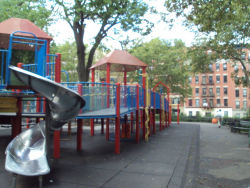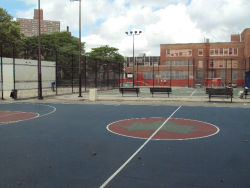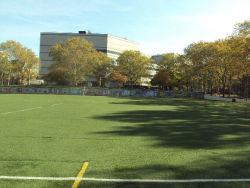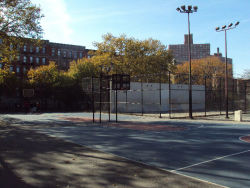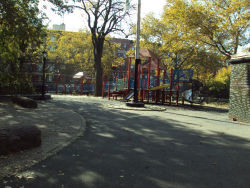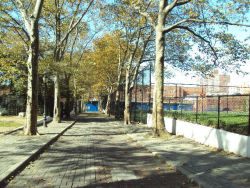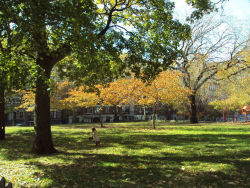Jacob H. Schiff Playground
Jacob H. Schiff Playground
What was here before?
This site was once home to the Hebrew Orphan Asylum of New York (HOA). Established in 1860 and originally based in Chelsea and then the Upper East Side, HOA’s rapid expansion precipitated the construction of a new campus. The building that occupied this site was designed by noted architect William H. Hume (1834-1899) and constructed in 1884. After decades of declining populations in the orphanage, it closed in 1941 and during World War II was converted into army barracks. Soon after the war, City College acquired the building for use as a classroom and dormitory, naming it “Army Hall.”
How did this site become a playground?
By 1952, the building was demolished to build a playground, which opened in 1956. This playground is a Jointly Operated Playground (JOP) serving P.S. 192 Jacob H. Schiff and the local community. Beginning in 1938, the Board of Education (now the Department of Education) agreed to provide land next to schools where NYC Parks could build and maintain playgrounds that could be used by the school during the day and by the public when school is not in session.
In 1987 the playground was renovated and renamed to match the adjacent school. It was reconstructed again in 2000 and 2004, which included a synthetic turf sports field, new bleachers, a drinking fountain, and new fencing. In 2005, the CITYarts organization installed Pieces for Peace, a 213-foot-long mosaic that incorporates artworks submitted by youth from around the world. The park’s basketball and handball courts were completely reconstructed in 2020.
Who is this playground named for?
This playground honors philanthropist and financier Jacob H. Schiff (1847-1920). Born into a middle-class Jewish family in Frankfurt, Germany, Schiff immigrated to the United States in 1865. Soon after his arrival in New York City, he found success as a Wall Street investment banker. In 1875, Schiff joined the banking firm of Kuhn, Loeb and Company. As a partner in the firm, and later as its senior partner, Schiff helped Kuhn, Loeb and Company become one of the most prominent investment companies in the world.
Conscious of the plight of many other Jewish immigrants, Schiff became involved in numerous charitable causes in the late nineteenth and early twentieth centuries. In 1884, he helped found the Jewish Montefiore Home, which treated the chronically ill among the city’s poor. With Schiff as its second president and primary benefactor, it rapidly expanded. Throughout the 1890s, Schiff also financed the work of public health advocates Lillian Wald and Mary Brewster and donated to the American Red Cross, the Visiting Nurse Service of New York, and Henry Street Settlement.
In addition to his charitable work for the poor and sick in New York, Schiff contributed to many educational institutions, including Columbia University, Harvard University, Cornell University, and Barnard College. Schiff helped found the Jewish Theological Seminary and funded the establishment of the department of Semitic Literature at the New York Public Library. Five years after Schiff’s death, Harvard recognized his generous support of education by creating the first Jewish Studies department in the United States in his honor. Schiff Mall and Seward Park’s Jacob H. Schiff Fountain in Lower Manhattan are bear his name.
Check out your park's Vital Signs
Clean & Safe
Green & Resilient
Empowered & Engaged Users
Share your feedback or learn more about how this park is part of a
Vital Park System

